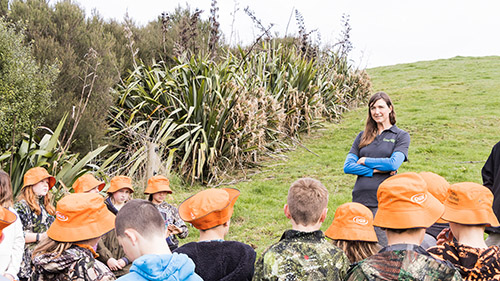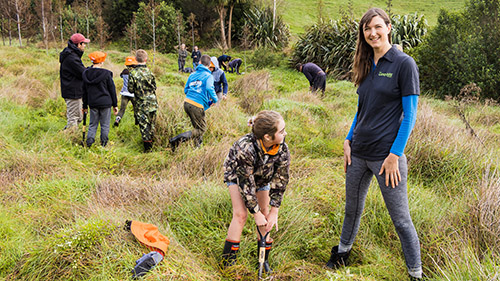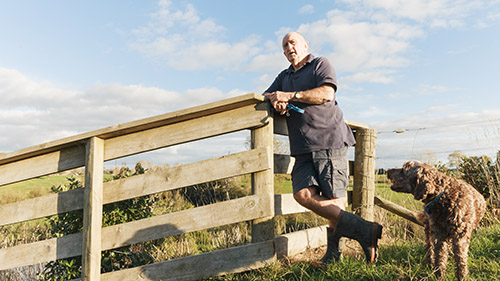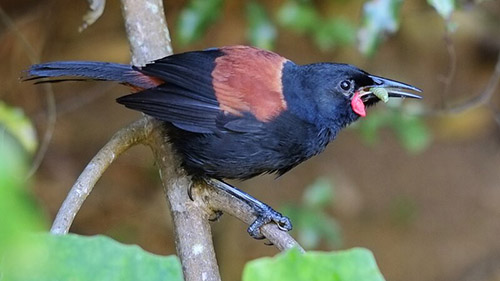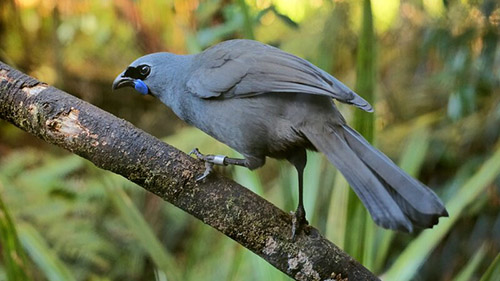 “As such, birds are already exploring habitat around the maunga, especially right next to Maungatautari. Landowners have seen robins and saddlebacks – tīeke – though they are not great flyers and won’t travel more than 500 metres over the fence.”
“As such, birds are already exploring habitat around the maunga, especially right next to Maungatautari. Landowners have seen robins and saddlebacks – tīeke – though they are not great flyers and won’t travel more than 500 metres over the fence.”
– Bexie Towle, project coordinator
A stream care group has spread its wings to become a much larger landscape restoration project, one that connects two ecologically significant maunga in the Waikato.
The Lower Mangapiko Stream Care Group, which was set up in about 2006 to manage willow and improve the water quality of the lower Mangapiko Stream, is now called the Maungatautari to Pirongia Ecological Corridor Incorporated Society to support the Taiea te Taiao project driven by NZ Landcare Trust. The project goal is to enable native species to move safely between the two mountains.
Project coordinator Bexie Towle says both maunga have significant biodiversity restoration projects, however, the land between them is mostly pasture.
Intensive farming over the years meant the waterways that connect the two had become highly degraded, and many landowners were keen to do something about that, says Bexie.
“Allowing the native species – the birds, the bats, the insects, the fish and even the invertebrates – that are thriving on these maunga to spread safely across the landscape is what has inspired this project.
“With overall biodiversity enhanced, the corridor will allow more species, including indigenous species and us humans, to thrive.”
The project works with landowners and involves creating “stepping stones” of native forest habitat, and includes predator control, erosion control and appropriate river management.
The stepping stones, planned to be no more than 3 kilometres apart, will follow waterways, mainly the Mangapiko, Maungahoi and Ngāparierua streams.
“There were so many mature kahikatea in the area that we believe this already is habitat for biodiversity, including bats and birds, but eventually we’ll get more sensitive species once they can travel across safely.
“As such, birds are already exploring habitat around the maunga, especially right next to Maungatautari. Landowners have seen robins and saddlebacks – tīeke – though they are not great flyers and won’t travel more than 500 metres over the fence.”
Maungatautari to Pirongia Ecological Corridor Incorporated Society chair Don Macky, who was also chair of the Lower Mangapiko Streamcare Group, is one such landowner.
“At our place in Paterangi, we have a family of about 12 kākā moving around the trees. Noisy buggers, they are. We thought they were magpies to start with and [my wife] Dinah wanted me to get the gun out. We hadn’t seen kākā on the farm for generations.”
Don says planting will not only provide a corridor for the birds but also help protect the waterways from permeation of chemical fertilisers and control water temperature to benefit aquatic wildlife, such as the invertebrates and eels.
Extensive restoration work has already happened, much by the former Lower Mangapiko Streamcare Group with “huge managerial and organisational assistance from the regional council and NZ Landcare Trust, and financial assistance from many sources – most by Waikato River Authority and Fonterra”.
Most of the Mangapiko Stream between Te Awamutu and Pirongia has already planted.
Funding from the Ministry for the Environment’s Freshwater Improvement Fund, applied for by New Zealand Landcare Trust, meant the group was able to employ two staff for five years to start making the project happen.
“Having them has made a whole heap of difference,” says Don, of project coordinator Bexie and mātauranga Māori facilitator Te Ao te o Rangi Apaapa.
While the society works closely with Waikato Regional Council and NZ Landcare Trust to get assistance with funding and riparian fencing and planting, those organisations “have other work to do, too, and now we have a real focus on making our project happen”.
“The goal is to support landowners to plant as many trees as it takes to create our ecological corridor,” says Don. “This is a 50-year project. It took generations to remove all the beautiful natives and it will take generations to put them back.”
Riparian fencing and planting will be added along the streams with an average setback of 5 metres, and existing tree stands be fenced off.
This planting season, over 100,000 plants are going in the ground.
“Most of them are through Waikato Regional Council, so we think the council is a bloody marvellous place,” says Don.
About 66,000 plants are coming through the council’s Shovel Ready Clean Streams 2020 project, which supports landowners in the Waikato region to plant out stream margins and is funded $1.98 million from Te Uru Rākau.
In addition to riparian planting, Taiea te Taiao will protect and enhance wāhi tapu (cultural sites of significance) and existing stands of kahikatea and totara. Landowners will also be encouraged to covenant sites of significance and, importantly, include predator control to protect long-tail bats that live in the corridor area and are sensitive to rats.
"When tīeke, robins, kōkako and hihi [stitchbirds] start to travel across the corridor in, say, 10 to 20 years’ time, we will need predator control to be a top priority,” says Bexie.
Partners in Taiea te Taiao include Pirongia Te Aroaro o Kahu Restoration Society, Maungatautari Ecological Island Trust, Maungatautari to Pirongia Ecological Corridor Incorporated Society, Ngāti Korokī Kahukura Trust, Purekireki Marae, Waikato Regional Council, NZ Landcare Trust, Waipā District Council, and Te Rūnanga o Ngāti Apakura.


